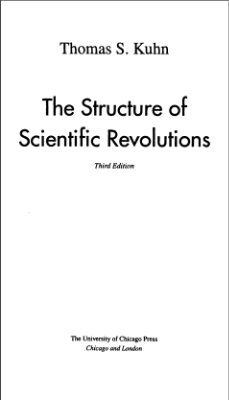University Of Chicago Press, 1996. - 226 p.
It’s been almost a half-century since the publication of Thomas S. Kuhn’s The Structure of Scientific Revolutions, a slim little book that introduced the word paradigm into common parlance and shattered our conventional way of looking at change. Fifty years on, it still represents perhaps the best thinking on how transformation happens, who drives it, why it’s so vehemently resisted, and what it really asks of people.
The book explores the psychology of belief that goves the acceptance of new concepts and innovations in science. Kuhn showed that the history of science is not one of linear, rational progress moving toward ever more accurate and complete knowledge of an objective reality. Rather, it’s one of radical shifts of vision in which a multitude of nonrational and nonempirical factors come into play.
Kuhn showed that the theories of Copeicus, Newton, and Einstein were all self-contained and incommensurable with one another. There was no steady accumulation of truth in the form of objective knowledge about the physical universe. Instead each theory was a revolutionary break from the previous theory, resulting in the arbitrary replacement of one conceptual matrix, or worldview, by another. Once the matrix changed, the way science was done and applied was fundamentally different.
It’s been almost a half-century since the publication of Thomas S. Kuhn’s The Structure of Scientific Revolutions, a slim little book that introduced the word paradigm into common parlance and shattered our conventional way of looking at change. Fifty years on, it still represents perhaps the best thinking on how transformation happens, who drives it, why it’s so vehemently resisted, and what it really asks of people.
The book explores the psychology of belief that goves the acceptance of new concepts and innovations in science. Kuhn showed that the history of science is not one of linear, rational progress moving toward ever more accurate and complete knowledge of an objective reality. Rather, it’s one of radical shifts of vision in which a multitude of nonrational and nonempirical factors come into play.
Kuhn showed that the theories of Copeicus, Newton, and Einstein were all self-contained and incommensurable with one another. There was no steady accumulation of truth in the form of objective knowledge about the physical universe. Instead each theory was a revolutionary break from the previous theory, resulting in the arbitrary replacement of one conceptual matrix, or worldview, by another. Once the matrix changed, the way science was done and applied was fundamentally different.

